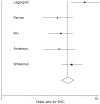Meta-analysis: the association of oesophageal adenocarcinoma with symptoms of gastro-oesophageal reflux
- PMID: 20955441
- PMCID: PMC3481544
- DOI: 10.1111/j.1365-2036.2010.04471.x
Meta-analysis: the association of oesophageal adenocarcinoma with symptoms of gastro-oesophageal reflux
Abstract
Background: Endoscopic screening has been proposed for patients with symptoms of gastro-oesophageal reflux disease (GERD) in the hope of reducing mortality from oesophageal adenocarcinoma. Assessing the net benefits of such a strategy requires a precise understanding of the cancer risk in the screened population.
Aim: To estimate precisely the association between symptoms of GERD and oesophageal adenocarcinoma.
Methods: Systematic review and meta-analysis of population-based studies with strict ascertainment of exposure and outcomes.
Results: Five eligible studies were identified. At least weekly symptoms of GERD increased the odds of oesophageal adenocarcinoma fivefold (odds ratio = 4.92; 95% confidence interval = 3.90, 6.22), and daily symptoms increased the odds sevenfold (random effects summary odds ratio = 7.40, 95% confidence interval = 4.94, 11.1), each compared with individuals without symptoms or less frequent symptoms. Duration of symptoms was also associated with oesophageal adenocarcinoma, but with very heterogeneous results, and unclear thresholds.
Conclusions: Frequent GERD symptoms are strongly associated with oesophageal adenocarcinoma. These results should be useful in developing epidemiological models of the development of oesophageal adenocarcinoma, and in models of interventions aimed at reducing mortality from this cancer.
Published 2010. This article is a US Government work and is in the public domain in the USA.
Figures
References
-
- [Accessed July 15, 2008];Fast Stats: Esophagus Cancer. Available at: http://seer.cancer.gov/faststats/selections.php.
-
- Bollschweiler E, Wolfgarten E, Gutschow C, Holscher AH. Demographic variations in the rising incidence of esophageal adenocarcinoma in white males. Cancer. 2001;92:549–55. - PubMed
-
- Lagergren J, Bergstrom R, Lindgren A, Nyren O. Symptomatic gastroesophageal reflux as a risk factor for esophageal adenocarcinoma. N Engl J Med. 1999;340:825–31. - PubMed
-
- Farrow DC, Vaughan TL, Sweeney C, et al. Gastroesophageal reflux disease, use of H2 receptor antagonists, and risk of esophageal and gastric cancer. Cancer Causes Control. 2000;11:231–8. - PubMed
-
- Wu AH, Tseng CC, Bernstein L. Hiatal hernia, reflux symptoms, body size, and risk of esophageal and gastric adenocarcinoma. Cancer. 2003;98:940–8. - PubMed


